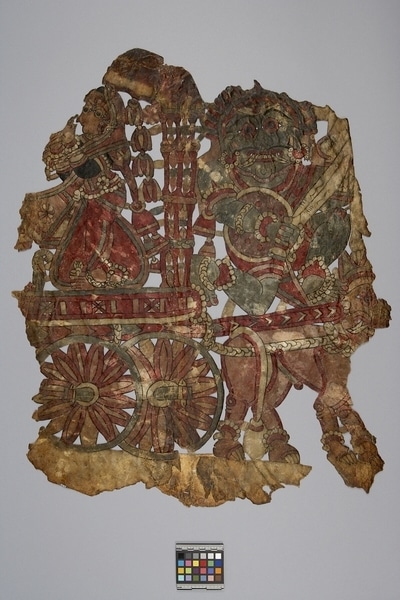Shadow Puppet Item Number: Ef225 from the MOA: University of British Columbia

Description
Shadow puppet of leather cut out representing a woman, and a part demon warrior, both astride a stylistic representation of a cart with flower petal wheels. The woman, whose face is in frontal and in profile view, has a chin tattoo, a decoration down her braid, toe rings, and anklets. Demon warrior is wearing chain link jewelry that also serves as horse trappings on the cart.
History Of Use
Puppetry, particularly shadow puppets, is an ancient dramatic form in India mentioned in the Buddhist Jataka Tales of the 3rd century B.C.E. Nowadays modern forms of entertainment, such as the Hindi film industry, have rendered them extinct except for some rural areas in the states of Orissa, Kerala, Andhra Pradesh, and Tamil Nadu. The Andhra Pradesh/Karnataka shadow puppet tradition, compared to the few remaining troupes, are the most extensive and dramatic. Probably originally Maharashtran and maintained by dynasties, such as the Vijaynagars of the 13th and 14th centuries, it now survives as presented by Marathi-speaking puppeteers, commonly called Raoji. These are the largest in size of the Indian shadow puppets.
Iconographic Meaning
Represents a scene from the Ramayana epic in which Ravanna, the demon king, abducts Sita, wife of Rama, the embodiment of divine splendour. They are astride the magical bejewelled cart called Pushpaka Ratha, pulled by a fanged demon horse, bound for Sri Lanka. Sita wears toe rings to symbolize her marriage to Rama. Two vertical lines on her forehead show her Vaishnavite faith. Ravanna has horizontal Shaivite marks.
Item History
- Made in Andhra Pradesh, India between 1880 and 1930
- Collected during 1976
- Owned by Tirukodur Ramamurthy
- Owned by Stephen Inglis before December 2, 1977
- Received from Museum of Anthropology Donations Fund (Funding source) and Stephen Inglis (Seller) on December 2, 1977
What
Who
- Culture
- South India
- Previous Owner
- Tirukodur Ramamurthy and Stephen Inglis
- Received from
- Museum of Anthropology Donations Fund (Funding source) and Stephen Inglis (Seller)
Where
- Holding Institution
- MOA: University of British Columbia
- Made in
- Andhra Pradesh, India
When
- Creation Date
- between 1880 and 1930
- Collection Date
- during 1976
- Ownership Date
- before December 2, 1977
- Acquisition Date
- on December 2, 1977
Other
- Condition
- fair
- Accession Number
- 0411/0232